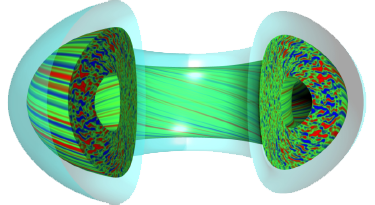Speaker
Description
In tokamaks, most diagnostics systems have a relatively small aperture, which limits the availability of only line-integrated measurements. The measurement represents line-integrated emissivity through the approximated line-of-sights (LOS), determined by pin-hole positions. By combining line-integrated measurements, tomography can reconstruct the two-dimensional (2D) distributions of physical quantities in a poloidal cross-section. Reconstruction of a space-resolved image or profile of a plasma quantity using tomography technology has been considered on many fusion devices. Typical tomography problems involve the existence, uniqueness, and process stability of the solution, and are ill-posed. In practice, the data analysis is challenging due to the insufficient coverage of LOS and errors on the measured data, the reconstruction done by any method will have uncertainties. In this work, a brief overview of several tomography technologies, including tokamak flux coordinate based Abel and Fourier-Bessel methods, and L-curve Phillips–Tikhonov, Maximum Entropy, constrained optimization (improved minimum Fisher information) methods for EAST multiple line-integrated measurement diagnostics, such as SXR, AXUV and Gas Electron Multiplier (GEM) camera, is present. Singular Value Decomposition (SVD) technology is commonly employed to obtain the perturbation signal or to remove noise for 2-D tomographic pattern. In particular, a method that introduces a Bayesian probability theory based Gaussian process tomography (GPT) technique has been developed to reconstruct the SXR emissivity distribution. It has certain advantages in uncertainty analysis and overcomes typical tomographic problems by considering a probabilistic approach. This method has already been implemented in the SXR or AXUV systems on multiple fusion devices, such as HL-2A, WEST and EAST. In theory, it can be extended to any line-integrated measurement diagnostic system. An additional advantage of this method is non-iterative and nonparametric, which can realize fast calculation and provide the possibility for real-time application (8 ms for a 50 × 50 pixels grid on a recent PC with MATLAB, the presently used algorithm minimum Fisher information easily reaches execution times up to seconds). Latest preliminary tests on SXR data using various designs of convolutional neural networks suggest the potential towards real-time reconstruction of impurity density profiles. Real-time application (~1ms for 75× 50 pixels grid output) of VGG-CNN method based on Pytorch framework (Python language) with strong GPU acceleration for EAST 92 channels SXR tomography has been carried out. The primary tomography of VGG-CNN shows good agreement to the Fourier-Bessel reconstruction regrading both equilibrium SXR emission and MHD-perturbed SXR emission. Besides of those much efforts in tomographic reconstruction been made for EAST line-integrated diagnostic, the numerical code output based forward modelling also have been developed for solving some special cases. Since each fusion device has been equipped with abundant of diagnostic systems, it is always necessary to explore new methods to effectively process the measurements in order to further understand the physical mechanism of plasma.
| Country or International Organisation | China |
|---|---|
| Affiliation | Institute of plasma physics, CAS |

